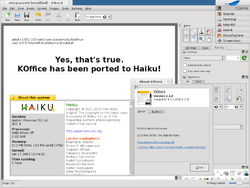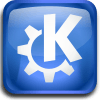KOffice
 | |
|
KPresenter 2.3 screenshot | |
| Original author(s) | KDE, Reginald Stadlbauer |
|---|---|
| Developer(s) | KDE, Thomas Zander (maintainer)[1] |
| Initial release | October 23, 2000[2] |
| Last release |
2.3.3
/ March 1, 2011[3] |
| Repository |
anongit |
| Development status | Discontinued |
| Written in | C++[4] |
| Operating system | Unix-like, Windows |
| Platform | Qt, KDE Platform |
| Size | ~70 MB (compressed source code)[5] |
| Available in | 27 languages[6] |
| Type | Office suite |
| License | GPL, LGPL |
| Website | koffice.org (Redirects to calligra.org)[7] |
KOffice was a free and open source office suite and graphics suite by KDE for Unix-like systems and Windows. KOffice contains a word processor (KWord), a spreadsheet (KSpread), a presentation program (KPresenter), and a number of other components that varied over the course of KOffice’s development.
After development began in 1997, two major versions of KOffice were released: Version 1.0 in 2000 and 2.0 in 2009. Following internal conflicts, the majority of KOffice developers split off in 2010 – resulting in the creation of Calligra Suite. Two years later, in September 2012, the KOffice.org website went offline.[8]
History
| Year | Venue | Date |
|---|---|---|
| 2000[9] | Erlangen, Germany | Sep, 23–25 |
| 2007[10] | Berlin, Germany | Oct, 26–28 |
| 2008[11] | Berlin, Germany | Nov, 7–9 |
| 2009[12] | Berlin, Germany | Jun, 5–7 |
| 2009[13] | Oslo, Norway | Nov, 27–29 |
| 2010[14] | Essen, Germany | Jun, 11–13 |
First generation
Initial work on KOffice development began in 1997, by Reginald Stadlbauer[15][16] with KPresenter, followed by KWord[17] in 1998.
In 1999, KOffice was cited in testimony in the United States v. Microsoft anti-trust trial by then-Microsoft executive Paul Maritz as evidence of competition in the operating system and office suite arena.[18]
The first official release of the KOffice suite was on October 23, 2000 when it was released as part of K Desktop Environment 2.0.[2] Versions 1.1 followed in 2001,[19] 1.2 in 2002,[20] 1.3 in 2004,[21] 1.4 in 2005,[22] and 1.5[23] and 1.6 both in 2006.[24]
Second generation
KOffice underwent a major transition as part of the release of KDE Software Compilation 4 (SC4). Coinciding with the work on SC4, the KOffice team prepared a major new release – KOffice 2.0 – which used the new KDE Platform 4 libraries. Although version 2.0 was released in 2009, the release was labeled as a “platform release” which was recommended only for testers and developers, rather than production use, since the release was missing key features and applications from the previous stable release series – Kexi, Kivio, and Kugar were not included.[25]

This continued with version 2.1 in November, 2009. Regular end-users requiring a stable environment are still recommended by developers to use the stable 1.6 release series.[26] This version was also ported to Haiku[27] but the port was later not updated for newer KOffice versions.
In May 2010, version 2.2.0 was released and brings an unprecedented number of new features and bugfixes. Kexi was integrated again. Kivio has not yet been migrated. A new framework for effects on shapes and a new import filters for the Microsoft Office Open XML formats that are used in MS Office 2007 and later got added.[28]
Community split

In mid-2010, following disagreements between the core developers,[29][30] the KOffice community split into two separate communities, KOffice and Calligra. Following arbitration with the community members several applications were renamed by both communities.[31] KOffice forked the KSpread spreadsheet utility to KCells, also the KPresenter presentation tool to KOffice Showcase, and the Karbon14 drawing tool to KOffice Artwork.
The community split coincided with the move from KDE’s Subversion repository to git. The Krita painting application, the Kexi database manager, and dedicated mobile platform GUI files were not migrated into the KOffice git repository.[32][33][34]
KOffice 2.3, released 31 December 2010,[35] along with subsequent bugfix releases (2.3.1–2.3.3[3]) was still a collaborative effort of both the KOffice and Calligra development teams.[36] An interim release, KOffice 2.3.3, was released in 2011.[3]
Beginning with KOffice 2.4 the developers aimed to release new KOffice versions every six months in sync with SC4 releases[37] but KOffice had seen no development activity since mid-March 2012.[38] As of September 2013, Calligra has released 2.4 and 2.5 and 2.6 and 2.7. After two minor commits in August 2012[39] the koffice.org website was replaced by a placeholder in early September 2012.[8] On October 22, 2012 KDE removed KOffice from their Quality Website Tools.[40]
As of 2014 KOffice was declared unmaintained by KDE.[41]
Components
The last formally released version of KOffice included the following components:
| KWord | A word processor with style sheets and frame-support for DTP-style editing of complex layouts. | |
 | KSpread | A spreadsheet application with multiple sheet support, templates and more than 100 mathematical formulae. |
 | KPresenter | A presentation program with image and effect support. |
| Kexi | An integrated data management application, designed as a Microsoft Access or FileMaker competitor. It can be used for designing and implementing databases, inserting and processing data and performing queries. It has limited compatibility with the MS Access file format. | |
| Kivio | A programmable flowchart drawing program with dynamically loadable stencils. Developed by theKompany, which offered additional (non-free) stencils for sale. | |
 | Karbon14 | A vector drawing application with a variety of drawing and editing tools – formerly known as Kontour and KIllustrator.[2] |
 | Krita | A digital painting program, with some image processing features – formerly known as Krayon and KImageshop. |
| Kugar and KChart | Integrated report and chart generators. | |
 | KFormula | An integrated mathematical formula editor. |
| KPlato | A project management application that can create Gantt-style charts. |
Technical details
KOffice applications are developed using Qt and KDE Platform. All its components are released under free software licenses and use OpenDocument as their native file format when possible. KOffice has been released separately from KDE SC 4 and can be downloaded from KDE’s FTP server.
KOffice 2 underwent a large overhaul to use the Flake system of components and Pigment color system, as much as possible within applications. KOffice developers planned to share as much infrastructure as possible between applications to reduce bugs and improve the user experience.[42] They also want to create an OpenDocument library for use in other KDE applications that will allow developers to easily add support for reading and outputting OpenDocument files to their applications.[43] Automating tasks and extending the suite with custom functionality can be done with D-Bus or with scripting languages like Python, Ruby, and JavaScript.[44]
See also
References
- ↑ "KOffice Overview". KDE. Retrieved 2012-05-01.
- 1 2 3 "KDE 2.0 Release Announcement". KDE. 2000-10-23. Retrieved 2012-05-01.
- 1 2 3 "KOffice 2.3.3 update". Lists.kde.org. 2011-03-01. Retrieved 2013-09-19.
- ↑ SVAKSHA (7 September 2010). "KDE-Koffice seeks code contributors".
- ↑ ftp://ftp.kde.org/pub/kde/stable/koffice-latest/
- ↑ "KOffice v2.3.1". Ithov.com. 2011-01-21. Retrieved 2013-09-19.
This version of KOffice is translated to no less than 27 languages.
- ↑ Archived copy of the official web site at the Wayback Machine (archived August 21, 2012)
- 1 2 Archived copy of the official website, showing a placeholder at the Wayback Machine (archived September 9, 2012)
- ↑ Dre (2000-09-30). "German-Sponsored KOffice Meeting Report". KDE. KDE.News. Retrieved 2011-05-21.
- ↑ Inge Wallin and Boudewijn Rempt (2007-10-30). "Second KOffice Sprint in Berlin Focuses on Release, Polish". KDE. KDE.News. Retrieved 2011-03-16.
- ↑ Jos Poortvliet (2008-11-11). "KOffice Sprint 2008". KDE. KDE.News. Retrieved 2011-03-16.
- ↑ Boudewijn Rempt (2009-06-13). "KOffice 2009 Sprint In Berlin". KDE. KDE.News.
- ↑ Jos Poortvliet (2009-11-29). "Second KOffice Developer Sprint 2009 Kickoff". KDE. KDE.News. Retrieved 2011-03-16.
- ↑ Boudewijn Rempt (2010-06-25). "KOffice 2010 Summer Sprint Report". KDE. KDE.News. Retrieved 2011-03-16.
- ↑ "koffice/kpresenter". KDE. Retrieved 2012-05-01.
- ↑ "Reginald Stadlbauer". Behind KDE. Retrieved 2012-05-01.
- ↑ "koffice/kword". KDE. Retrieved 2012-05-01.
- ↑ "Microsoft's 3rd man speaks out fear of KOffice". KDE. 1999-01-30. Retrieved 2012-05-01.
- ↑ "KOffice 1.1 Release Announcement". KDE. 2001-08-28. Retrieved 2012-05-01.
- ↑ "KDE Ships KOffice 1.2, an Integrated Office Suite for Linux/Unix". KDE.News. Retrieved 2012-05-01.
- ↑ "KOffice 1.3 Released". KDE.News. Retrieved 2012-05-01.
- ↑ "KOffice 1.4 Released". KDE.News. Retrieved 2012-05-01.
- ↑ "KOffice 1.5 Released". KDE.News. Retrieved 2012-05-01.
- ↑ "KOffice 1.6 Released". KDE.News. Retrieved 2012-05-01.
- ↑ "KOffice 2.0.0 released". KDE. 2009-05-28. Archived from the original on 2011-06-07. Retrieved 2012-05-01.
- ↑ "KOffice 2.1 released". KDE. 2009-11-24. Archived from the original on 2011-06-07. Retrieved 2012-05-01.
- ↑ "KDE applications available for Haiku!". Tiltos.com. Retrieved 2013-09-19.
- ↑ "KOffice 2.2 Released". KDE. 2010-05-27. Archived from the original on 2011-07-17. Retrieved 2012-05-01.
- ↑ "KOffice split". KDE. 2010-10-23. Retrieved 2013-05-04.
- ↑ "Re: KOffice split". KDE. 2010-10-26. Retrieved 2013-05-04.
- ↑ "KOffice arbitration is finished". KDE. Retrieved 2012-05-01.
- ↑ "CALLIGRA_HAS_MOVED_TO_GIT". KDE. Retrieved 2012-05-01.
- ↑ "KOFFICE_HAS_MOVED_TO_GIT.txt". KDE. Retrieved 2012-05-01.
- ↑ "KOffice Repository". KDE. Retrieved 2012-05-01.
- ↑ "KOffice 2.3.0 Released". KDE. 2010-12-31. Archived from the original on 2011-06-07. Retrieved 2012-05-01.
- ↑ "Calligra Suite Goes Active". KDE. 2010-12-06. Retrieved 2012-05-01.
- ↑ "Re: Platform support / Roadmap". KDE. Retrieved 2012-05-01.
- ↑ "KOffice activity (Note: Script Kiddy is an automated maintenance bot, not a developer)". KDE Projects. 2012-07-18. Retrieved 2012-07-18.
- ↑ "KOffice activity (Note: Script Kiddy is an automated maintenance bot, not a developer)". KDE Projects. 2012-08-19. Retrieved 2012-12-04.
- ↑ "KDE Quality Website Tools activity". KDE Projects. 2012-10-22. Retrieved 2012-12-04.
- ↑ "KOffice – Overview – KDE Projects". KDE.
Unmaintained Projects » KOffice
- ↑ "KOffice 2.0 Alpha 5 Released". KDE.News. Retrieved 2013-09-19.
- ↑ "KOffice ODF Sprint Report". KDE.News. Retrieved 2013-09-19.
- ↑ Kross Scripting Framework
External links
| Wikimedia Commons has media related to KOffice. |
- Archived copy of the official web site at the Wayback Machine (archived August 21, 2012)
- KOffice development home



